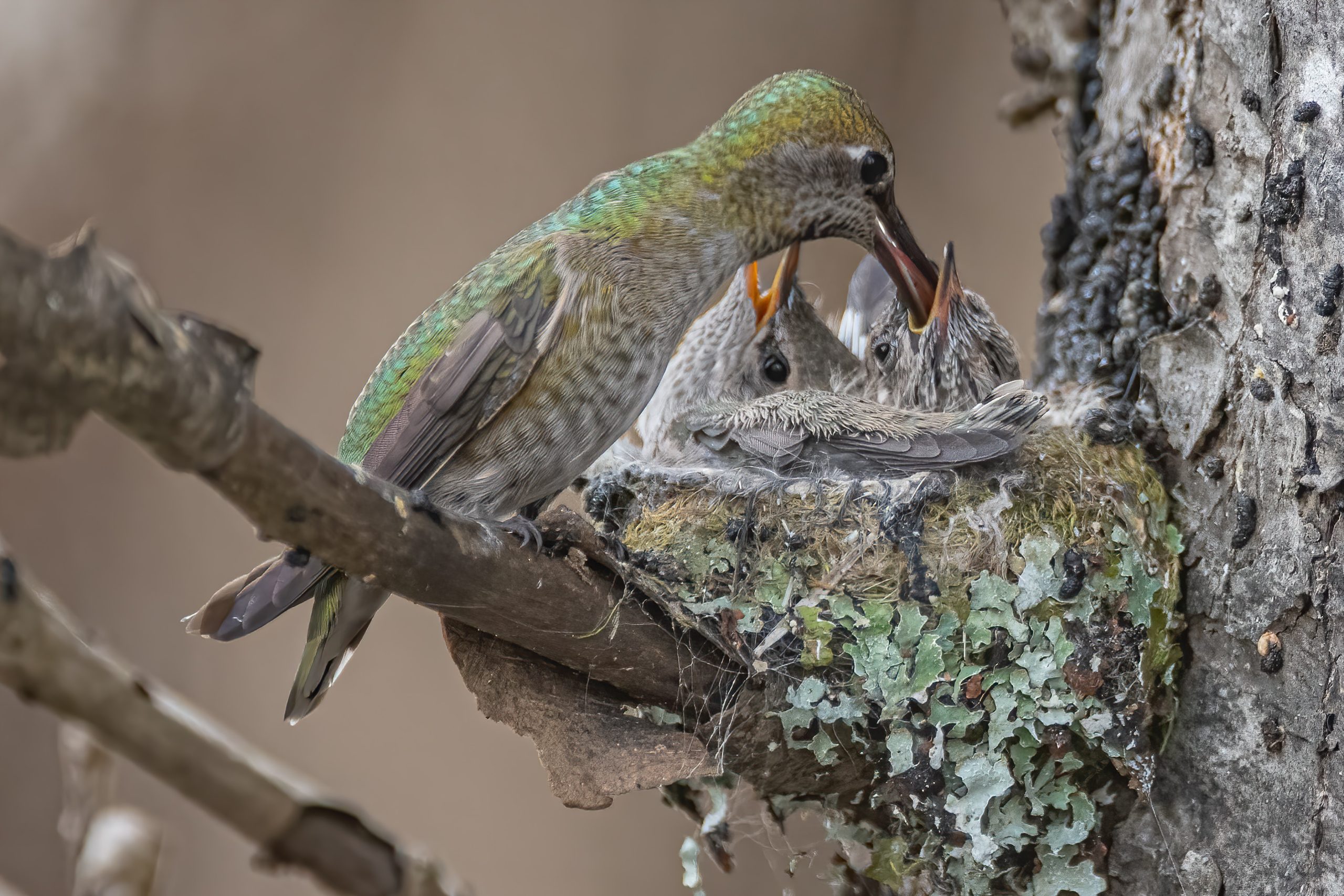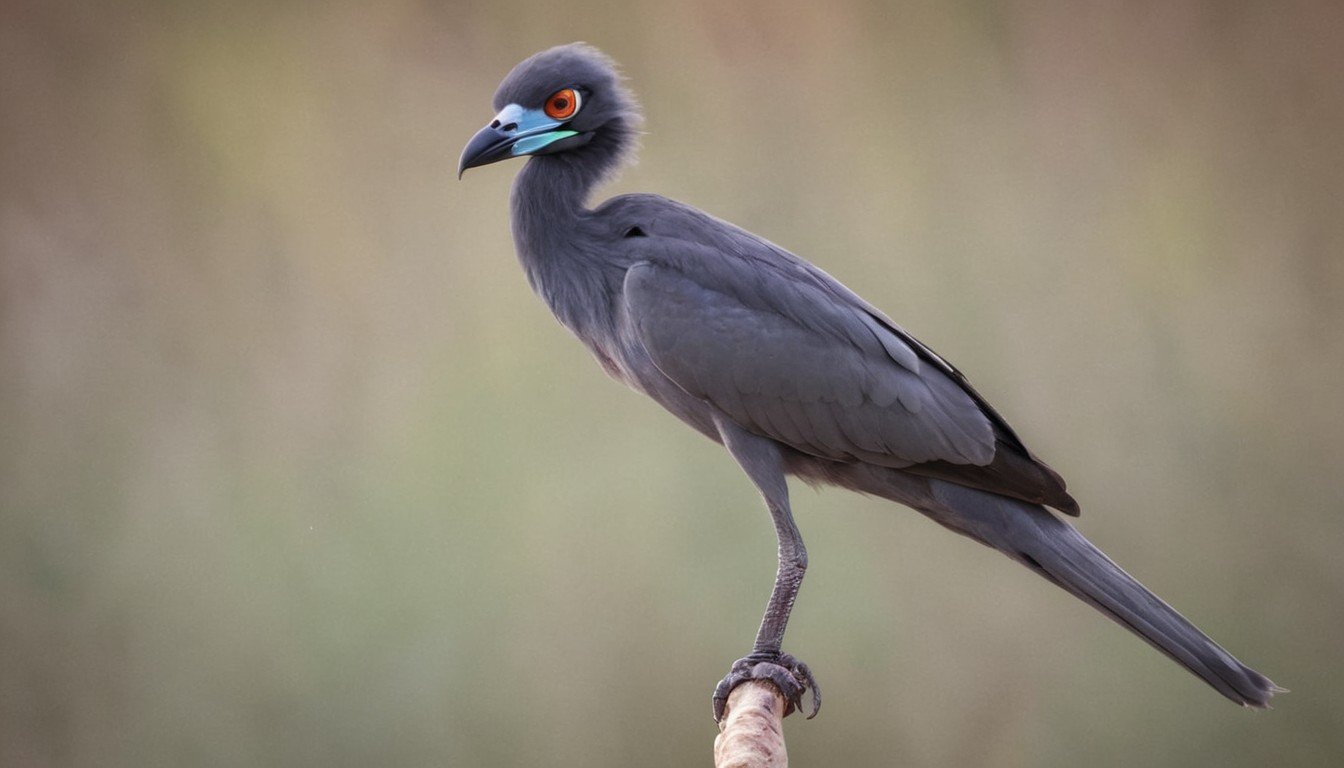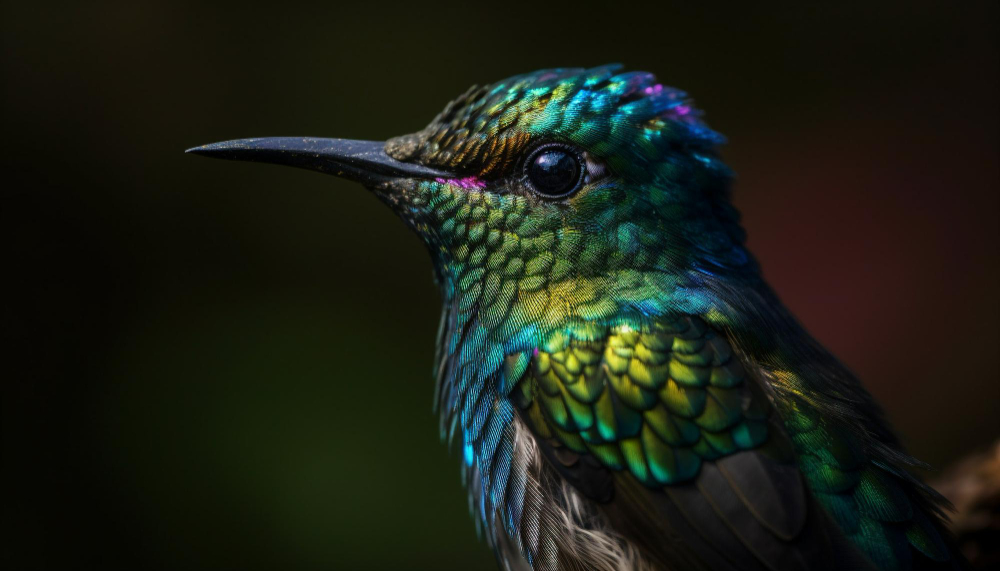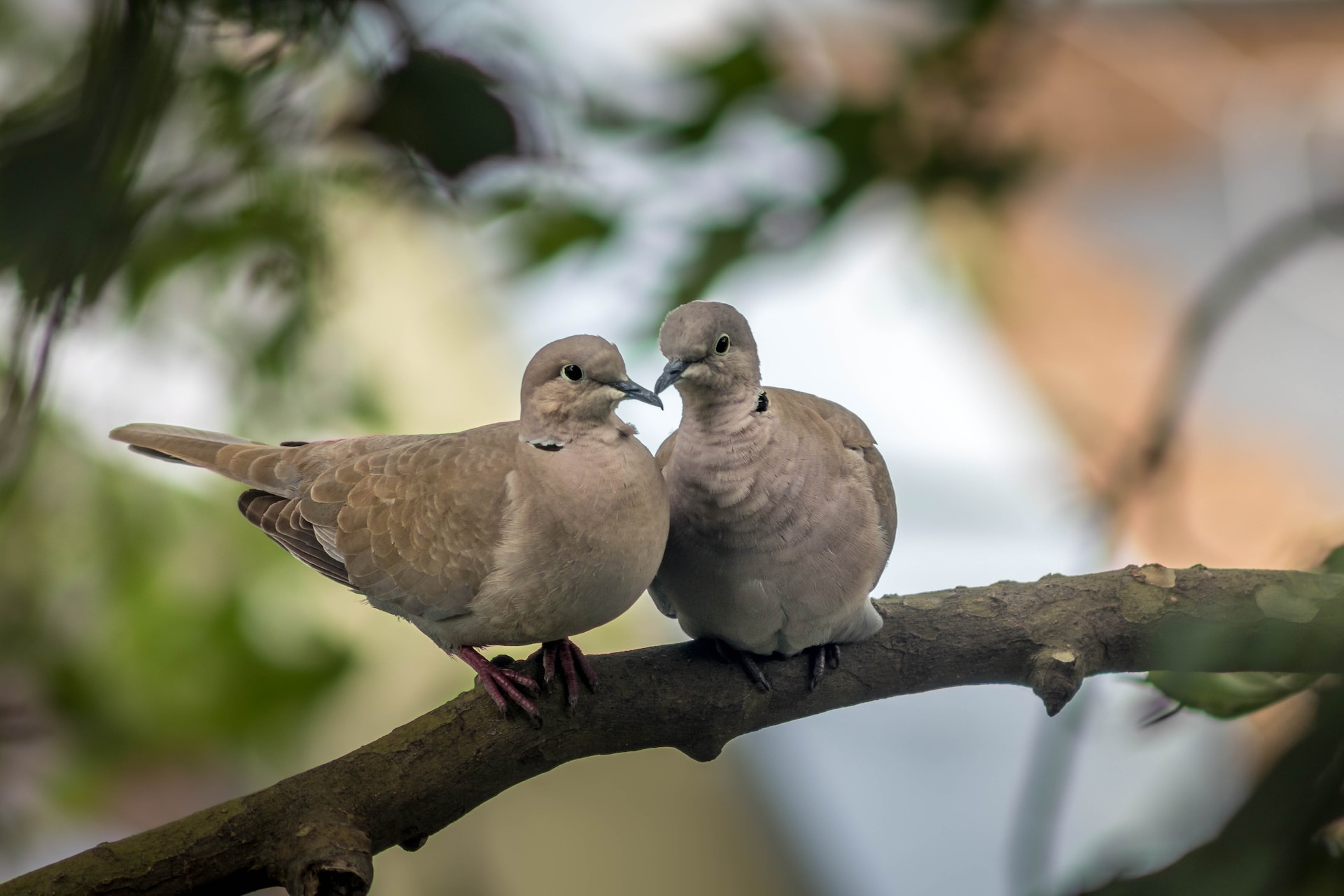Hummingbirds are some of the most fascinating birds on the planet. Known for their speedy flight and ability to hover in midair, hummingbirds have captured the fascination of people for centuries. An integral part of the hummingbird’s life is its intricately built nest. But “Who Makes the Hummingbird Nest?” Let’s take a closer look at the nest building process of these aerial architects.
The Female Hummingbird is the Nest Builder
The duty of nest construction falls solely on the female hummingbird. The males play no part in selecting the site, gathering materials, or crafting the nest. Here are some key facts about the female hummingbird’s nest building:
- She selects the nest location on her own, often choosing a high tree branch, tall shrub, or other elevated site. This helps protect the nest from predators.
- Gathering nest materials is a meticulous process. She may inspect hundreds of plant fibers, mosses, and feathers before selecting just the right ones.
- Using her beak and feet, she intricately weaves the materials together to form a strong, stretchy cup-shaped nest perfectly sized for her tiny body.
- The building process takes 6-12 days from start to completion depending on the species. She works diligently each day to finish it.
- She uses spider silk and sticky gums to bind the materials and decorate the nest exterior with lichens or moss for camouflage.
So from start to finish, it is solely the female who uses her specialized skills to masterfully construct the hummingbird nest. The male plays no role other than mating and occasionally helping feed hatchlings.
Why the Female Builds the Nest Alone
You may wonder why the male hummingbird does not participate at all in nest building. There are a few key reasons for this division of labor:
- Energy conservation – The fast hummingbird metabolism requires the males to focus entirely on feeding to maintain energy. Building a nest would burn too much of their limited energy reserves.
- Lack of skill – The female’s beak and feet are specially adapted for precise weaving and shaping of the nest materials. Males lack this dexterity.
- Protection of territory – Males must constantly defend their nectar-rich feeding territories from intruders. This leaves no time for nest duties.
- Attracting mates – The males focus on aerial displays, chases, and elaborate courtship rituals to attract females. Building nests would detract from mating efforts.
So the nest building duty falls solely on the female, while the male dedicates himself completely to feeding, mating, and defending territory. This division of labor maximizes efficiency and plays to their unique adaptations.
Hummingbird Nest Characteristics by Species
While all hummingbird nests share the core concept of a small basket for eggs and chicks, adaptations exist tailored around habitat and climate norms aligned with individual species spread across North and Central America totaling over 300 different kinds from Alaska to Costa Rica:
Anna’s Hummingbird
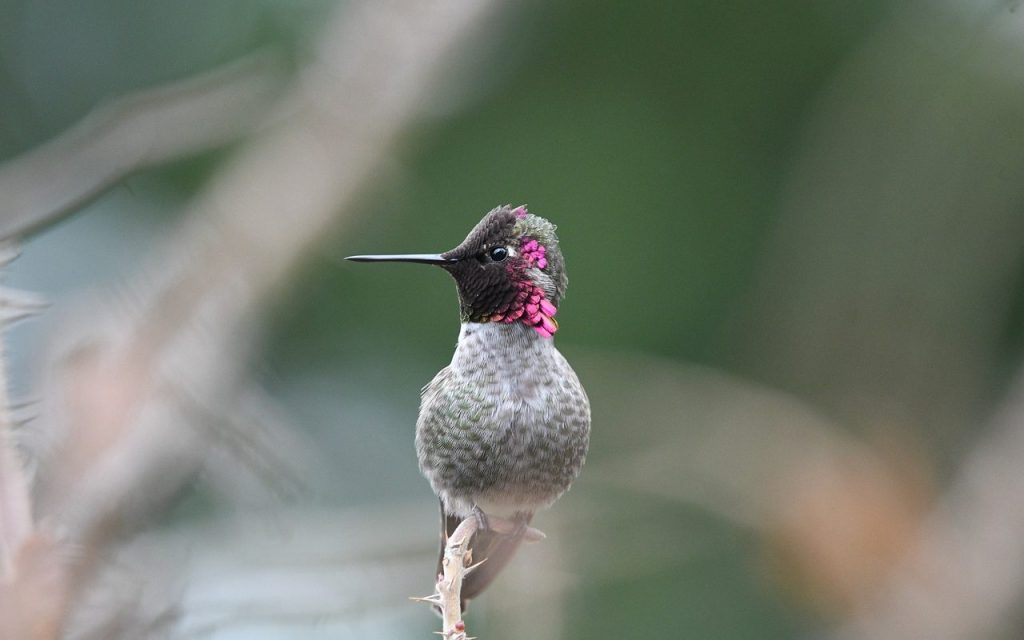
This pacific coastal resident constructs a sturdier bowl up to two inches wide externally anchored using spider silk and moss bound with bits of bark and lichen when available lining the walls then overlaying the turned-up rim before padding the interior deeply with feathers.
Allen’s Hummingbird
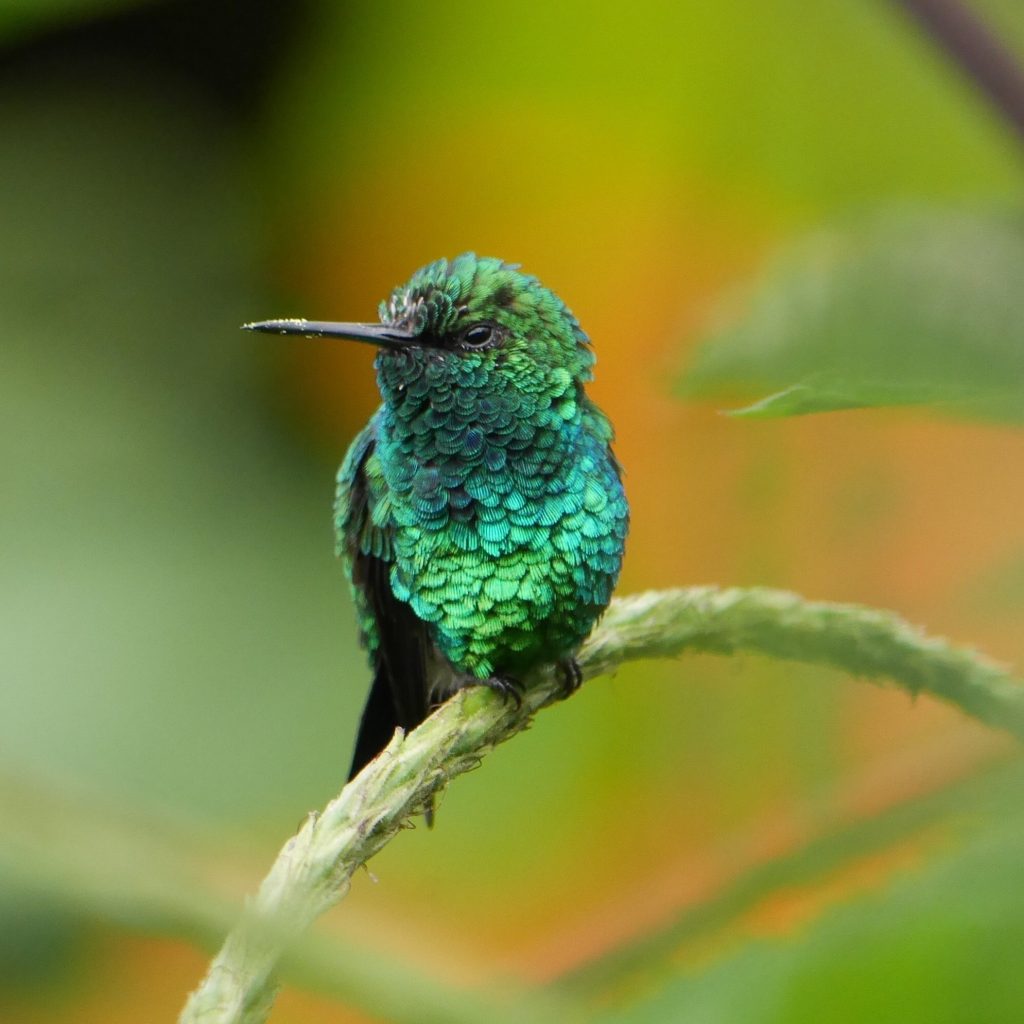
Also ranging along the California and Southwest U.S. regions, Allen nest’s demonstrate a compact tapered profile only 1.5 inches wide x 1.75 inches tall made from a wider variety of materials from leaf fragments to shed blooms built up in layers then bound into place with extensive spider silk strands fused to a supporting twig.
Broad-tailed Hummingbird
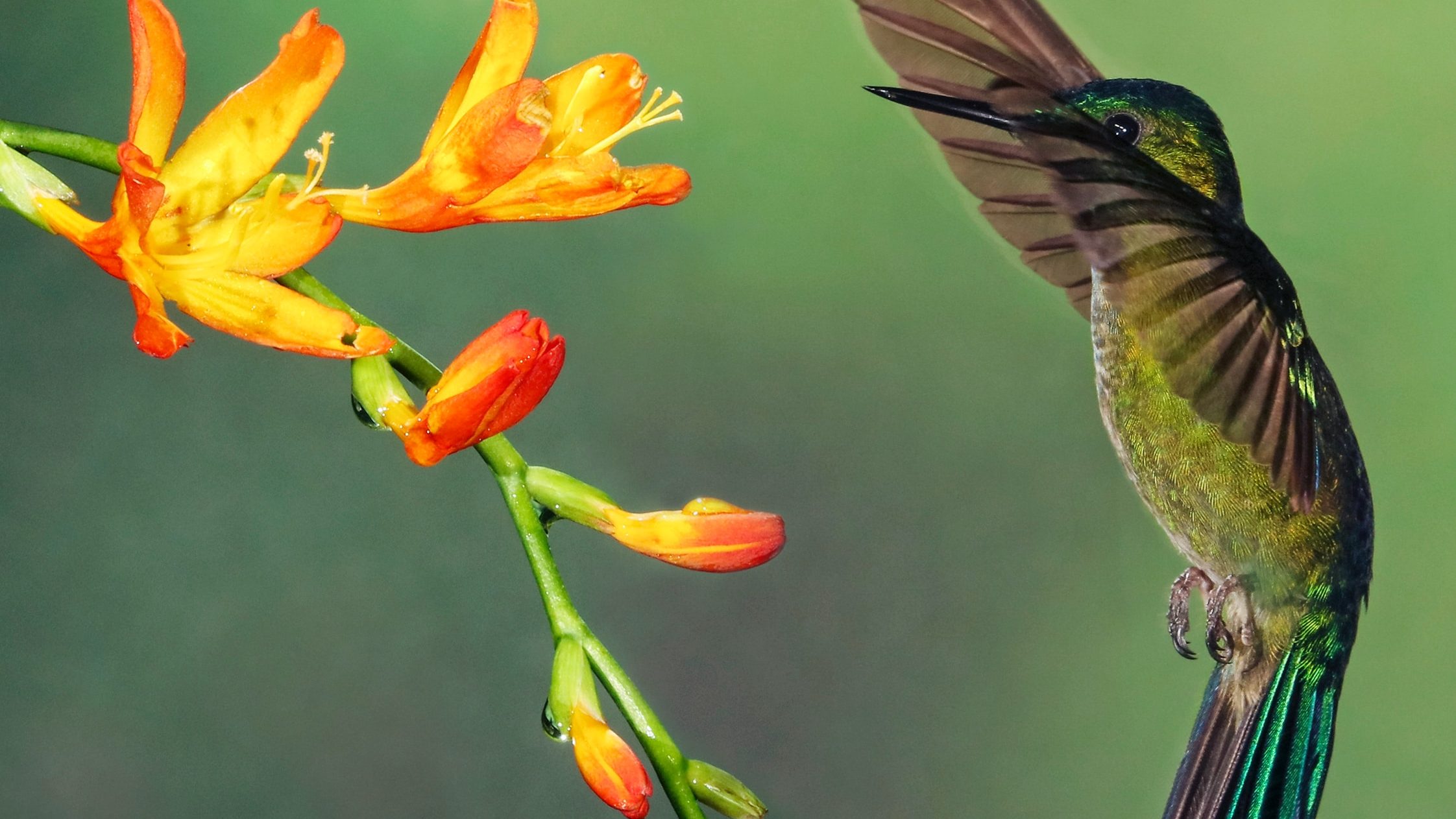
Adapted to exposed mountain meadow conditions subject to cold and wind, this high elevation nester of the Rockies insulates its tiny nest cup exceptionally thickly using thistle down contacted with sturdy bands of silk to a drooping outer branch up to 25 feet overhead of small firs.
Table 1 compares key hummingbird nest architecture indicators by prominent species:
| Species | Location | Dimensions | Anchor Support | Materials |
|---|---|---|---|---|
| Ruby-throated | Eastern deciduous & pine | 1.5″ diameter x 1.25 high | Downward thin branches | Bud scales, lichen, silk |
| Black-chinned | Southwest river groves | 1.25″ diameter x 1″ high | Tree cluster | Bark bits, dry leaves |
| Rufous | Northwest forest/meadow | 1″ diameter x 1.5″ high | Conifer needle tips | Moss, fur blooms |
Where Do Hummingbirds Get Nest Materials?
Hummingbird nests may appear delicately built, but they are constructed from some surprisingly tough and durable materials. Here are the most common sources hummingbirds get their nest-building supplies from:
- Plant fibers – Fibers from stalks, stems, and bark provide the basic building framework. Some common sources are milkweed, cattail, thistle, mullein, dandelion, cedar, and cottonwood.
- Spider silk – Strong flexible spider silk binds the nest materials and is used to “sew” the outside decorations on.
- Mosses and lichens – Abundant mosses, lichens, and green algae provide a soft interior lining and camouflage exterior.
- Feathers – Small downy feathers from other birds provide insulation and padding. The female may even pluck fur from tree squirrels!
- Tree sap and gums – Sticky saps act as effective adhesives to firmly bind materials together.
In addition to these natural materials, hummingbirds have adapted to modern times and will occasionally incorporate synthetic fibers, cigarette butts, bits of trash, and human-made fibers into their nests!
Unique Adaptations for Nest Building
Hummingbirds have several unique physical and behavioral adaptations that allow them to construct their remarkable nests:
- Precision beak – The long slender beak has slight serrations on the inside edge ideal for grasping fibers and intricately weaving them into place.
- Swift flight – Their speed and maneuverability helps them visit hundreds of sources to find the perfect materials.
- Sharp vision – Excellent eyesight allows detection of tiny fibers and superb nest decoration with camouflage.
- Dedication – Hummingbirds have an incredible focus and persistence, working from dawn to dusk to complete the nest in time.
- Expanded memory – They have an enlarged hippocampus region of the brain allowing them to recall nest locations and materials sources.
- Carriage stability – Hummingbirds can transport materials weighing 2-3 times their body weight back to the nest while in flight!
These behavioral and physical adaptations enable the female hummingbird to build her meticulously crafted nest using the most suitable materials she can find in nature.
Nest Materials Collection Process
Collecting the materials for the nest is almost as impressive as the construction itself. Here is the typical process a female hummingbird goes through:
- She will identify a general nesting area but make frequent short building flights to survey specific anchor points.
- With a site selected, she begins gathering the cottony plant fibers that form the basics of the structural framework.
- She carefully extracts the most flexible, elastic fibers pulling them apart with her serrated beak rather than biting them off.
- Holding the materials in her beak, she flies back to deposit them, then rapidly sets off for more. She may make hundreds of these gathering trips.
- As the foundation takes shape, she becomes more selective, finding the fluffiest feathers, most camouflaging lichens, and stickiest sap to incorporate.
- She constantly assesses materials on touch, texture, and elasticity before deeming them worthy of adding to her nest.
- In the final stages, she decorates the exterior with precisely woven patterns of spider silk for strength, beauty, and camouflage.
The entire process requires persistence, energy, sharp cognition, and attention to detail that is truly impressive for such a tiny bird.
Structure and Characteristics of the Nest
The completed hummingbird nest is an engineering marvel. Here are some of its key structural characteristics:
- Size – Typically 2-2.5 inches wide and 1-1.5 inches deep – just enough for the female’s body.
- Shape – A stretchy shallow cup just slightly wider than the bird’s width. Allows incubation of eggs against her body.
- Thickness – Walls are a mere 1-2 millimeters thick yet tightly woven enough to support the eggs.
- Texture – Exterior decorated with soft lichens and mosses to disguise it among the vegetation.
- Interior – Lined with the finest downy plant fibers and feathers for cushioning.
- Flexibility – Nests can stretch up to double their size to accommodate growing hatchlings.
- Durability – Made to last only one season but sturdily built with climate appropriate materials.
The hummingbird skillfully constructs her nest with the optimal shape, size, thickness, flexibility, insulation, and camouflage to not only support the eggs but also expand for the hatchlings’ growth.
Where do hummingbirds nest?
Tree Branches – Preferred protected sites offer stabilizing support without excessive swaying from winds that could eject eggs yet allow protective concealment thanks to encircling leaves and pliable peripheral twigs facilitating weaving into basket shapes.
Vegetable Fibers – Silky seed filaments, insulating thistle/cattail down, flexible grasses/ bark strips supply durable, quick-drying indigenous construction materials.
Building Ledge – Forked branching, bark ridges/knots create solid anchor points allowing suspension across gaps letting air flow to regulate incubation temperatures while deterring some predators.
How big is a hummingbird nest?
The minuscule dimensions of completed hummingbird nests merely 1-2 inches wide and deep underscores the nickelsized owners fitting inside along with typically just two pea-sized eggs laid in sequence a day apart. But the expansive energy investment required to source hundreds of silk strands, downy filaments, bits of foliage and other unique materials which female hummingbirds meticulously intertwine into cohesive cups with tailored suspension dynamics amounts to relatively immense installation efforts relative to the actual square footage when considering builders weigh only 3-5 grams on average!
Unique Nesting Behaviors
Once built, the hummingbird nest serves as more than just a physical structure for the eggs and chicks. The female exhibits some unique behavioral instincts related to the nest:
- She will aggressively defend the nest from any intruders, even much larger birds, mice, and lizards.
- To protect from rain, she “shingles” the exterior by layering materials from the top down like roof shingles.
- She often builds multiple backup nests in a season then abandons them – up to 6 unused nests per year!
- If the eggs or hatchlings fall from the nest, she may carry them back in her feet or beak.
- To make repairs, she will use regurgitated saliva as a sticky adhesive to patch holes or add materials.
- She feeds hatchlings while perched on the rim, occasionally entering the nest to remove fecal sacks.
- Once the chicks fledge, she will disassemble the nest and reuse the materials to build a new one.
These behaviors demonstrate the female’s ongoing attention and care for the nest site. It is not just where the eggs are laid, but an integral part of rearing her young.
When and Where Nests Are Built
Hummingbirds carefully time their nest building and select strategic locations:
- Spring – Nest building begins as early as late winter in warmer areas, spanning from March through May farther north.
- Solitary – Each female builds her own nest. No colony nesting.
- Concealed sites – Usually high on a down-sloping branch away from trunk, or hidden in shrubs, trees, vines, or leaves.
- South facing – She prefers a south facing site for maximum sunlight and warmth.
- Near nectar – Nest is built in the center of the female’s prime feeding grounds so she never has to leave the hatchlings for long.
- Multiple nests – She builds up to 6 or more practice nests before settling on one to use for her brood.
By carefully timing her nest building to the season and selecting concealed sites near food, the female hummingbird sets her eggs up for the best chance of survival.
Hummingbird Nest Facts
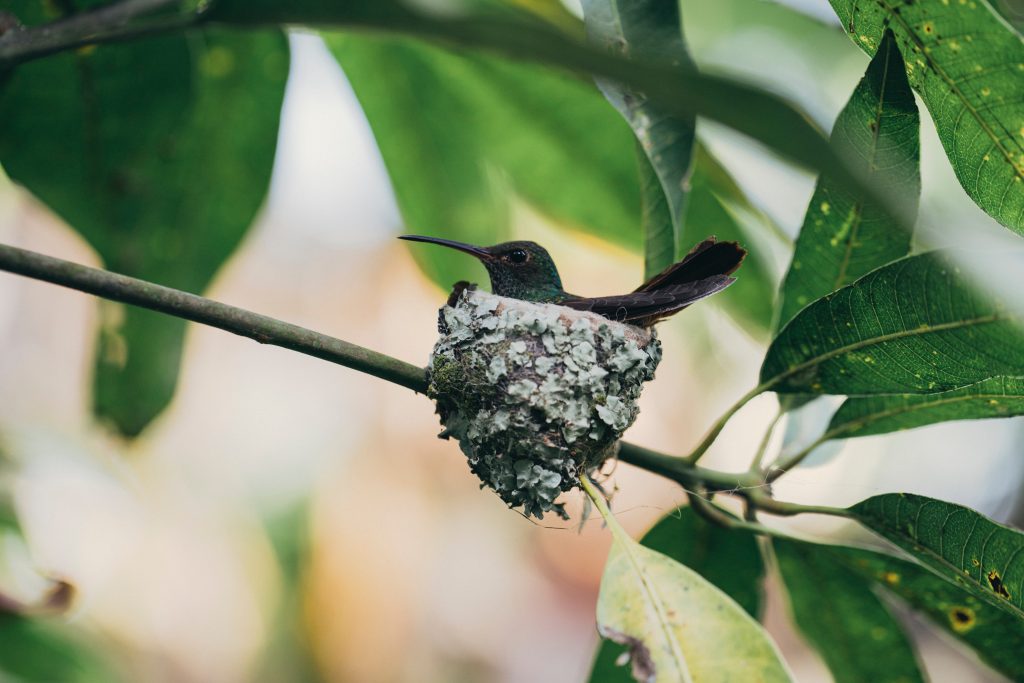
Hummingbird nests represent intricate examples of precision fabrication in the avian world. While diminutive in absolute size given the tiny dimensions of these species, the expansive effort and architectural details invested into constructing a durable shelter to house and incubate fragile eggs speaks to hummingbirds’ evolutionary mastery adapting over eons. Understanding nuances around nest sourcing dynamics along with characteristic structures built to protect subsequent generations offers insight into hummingbirds’ critical reproductive processes.
Attracting Hummingbirds to Nest
Encouraging nest establishment by breeding hummingbirds in a backyard habitat starts with providing suitable source materials for gathering into place combined with appropriately sized and oriented construction sites:
Nesting Materials – Supplying abundant airborne cottony fibers from vegetation like thistle down or mullein stalk fur allows collection suggesting insulation needed to buffer eggs. Evergreen groves also give up wispy bark bits and pliable twigs.
Construction Anchors – Position sturdy branching trees, upright cacti pads or poles with accessible angles facilitating nest anchorage through rain, wind and other turbulence.
Feeders as Territory Beacons – Energetic males will patrol nectar feeders as virtual signals of plentiful food enticing visiting females to settle nearby. Stock extra feeders triggering competitive aerial displays.
Water Features – Rainbow misters or drippers offer drinking and bathing opportunities also suggesting hospitable conditions favorable towards mating, incubating and ultimately parenting chicks through summer months.
Hummingbird nest success improves by thoughtfully augmenting key habitat offerings that spark breeding site fidelity reactions genetically programmed when specific spring environmental cues get stimulated. Soon, a new generation takes wing thanks to supportive interventions.
Are Hummingbird Nests Reused?
Hummingbirds put tremendous effort into building a secure, comfortable nest. But are their nests ever reused for a second brood? Here’s what we know:
- A female will reuse her own nest for a second clutch in the same season, repairing and refreshing it between broods.
- Females do not return to a successful nest from previous years; a new site is chosen each season.
- Once a nest fledges a brood, she may disassemble it to reuse the materials in building her next nest.
- Severe storms may destroy nests before eggs can hatch, in which case she will rebuild on the same site.
- Intact empty nests are occasionally reused by other species like finches or swallows but not hummingbirds themselves across seasons.
So while hummingbird nests may see a few reuse cycles within a breeding season, they do not survive long term across years. The female intricately crafts a new architectural masterpiece each spring.
Threats and Dangers to Hummingbird Nests
Despite being well engineered and concealed, hummingbird nests face many threats from both nature and manmade factors:
- Predators – Jays, crows, snakes, squirrels, and domestic cats are common predators, especially when nests are built low or on the ground.
- Weather – High winds, hail, and torrential rain can damage nests. Long cold snaps may kill hatchlings.
- Tree trimming – Power companies trimming trees before nesting ends can destroy sites.
- Habitat loss – Logging, fires, development, and land clearing reduce safe nesting spots.
- Pesticides – Chemicals weaken eggshells and poison nestlings through the mother’s contact.
- Climate change – Rising temperatures and erratic weather may desynchronize nesting from food supplies.
To support hummingbird reproduction, preserving diverse native vegetation through sustainable practices is key. Homeowners can help by delaying trimming, keeping cats indoors, avoiding pesticide use, and planting hummingbird-friendly flowers. Providing a proper nesting habitat ensures the nest builders survive to continue amazing us.
Can I touch a hummingbird nest?
Finding an active hummingbird nest signals remarkable luck worth appreciating visually from a distance rather than through physical contact seeking temporary gratification ignoring unintended consequences. Fleeting handling by curious yet ignorant humans risks permanently interrupting essential incubation ,kill developing chicks due to temperature extremes, alert predators now tuned to vulnerability temptingly only protected by a fragile parents or might scare off that lone mother abandoning hopes for an intact brood this season after exhaustive sourcing and construction efforts now squandered thoughtlessly. Consider instead simply pausing a moment to admire nature’s poignant handiwork untarnished by selfish actions amidst so much needless interference elsewhere these days if we hope to achieve sustained balance across shared habitats worth protecting.
Do hummingbirds leave their nests at night?
Hummingbirds rely on external warmth from sunlight, surrounding air and contact incubation through parent brooding rather than internal heat generation while developing embryos or nestling chicks. So adult birds cannot sustain offspring by night as lower temperatures arrive. In response, female hummingbirds settle carefully onto nests soon after darkness encroaches to shield the contents beneath tailored body profiles supplying residual warmth accumulated preceding daytime hours. Body down further insulates externally. By not abandoning offspring overnight, devoted parents demonstrate a remarkable commitment towards ensuring the next generation survives through each dusk-to-dawn interval intact.
Conclusion: Who Makes the Hummingbird Nest?
Hummingbird nests are some of the most astounding examples of bird architecture and engineering. Though diminutive, hummingbirds construct sophisticated featherweight yet durable nests solely using materials found in nature. It is solely the female hummingbird who undertakes each step of nest site selection, material gathering, and meticulous construction process. Their specialized adaptations allow them to build these remarkable structures critical to protecting their eggs and raising the next generation. While threats exist from humans and nature, we can support hummingbird reproduction by respecting their nesting habitats and building needs. Understanding the hummingbird creator behind these aerial gems gives us a deeper appreciation of the skills and instincts of these captivating birds.
FAQs
Who makes hummingbird nests?
The female hummingbird alone is responsible for all aspects of nest construction, from choosing the site to gathering materials to weaving the structure. Males contribute only to mating and feeding duties.
How do hummingbirds build nests?
Using plant down, spider silk, lichens, and feathers, the female hummingbird intricately weaves a stretchy shallow cup attached to a high branch. Her beak allows precision manipulation of materials.
Why don’t male hummingbirds build nests?
Energetically costly activities like nest building would detract male hummingbirds from priorities like feeding and mating displays. Females are specially adapted for construction.
What materials do hummingbirds use in nests?
Hummingbird nests are made from plant fibers, spider silk, lichens, mosses, feathers, and held together by tree saps. Synthetic fibers are sometimes incorporated too.
How long does it take hummingbirds to build nests?
On average, hummingbird nest construction takes 6-12 days from start to finish. Smaller species build more rapidly. The process is lengthy to find the best quality materials.
Do hummingbirds reuse old nests?
Females may reuse their nest for a second brood within a breeding season but build a completely new one each spring. They do not return to previous years’ nest locations.
How can I protect hummingbird nests?
Avoid trimming vegetation in nesting season, keep pets indoors, use natural pest control, and plant native flowers to support their food sources. Monitoring nests from a distance respects their space.
Why do hummingbirds build multiple nests?
It is common for a female to build up to 6 practice nests before settling on one to use. This may ensure construction skills or serve as decoy nests to divert predators.

